The Kinetica Art Fair brings together independent galleries, art organisations and curatorial groups who focus on kinetic, electronic, robotic, sound, light, time-based and multi-disciplinary new media art, science and technology. The art fair features installations, robots and small sculptures but also live performances, artists presentations, demos and a cheerful atmosphere that makes it easy to talk to the ‘exhibitors.’
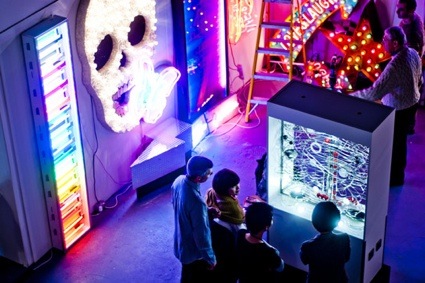 Image Timeout
Image Timeout
The event takes place in London every year since 2009 but this was the first time i managed to be in town during the fair. Kinetica is as bazaar, as garage and as male-frequented as you might expect. There were a couple of interactive horrors “customizable to better suit the lobby of your luxury hotel”, and a few aesthetically questionable contraptions. It takes all sorts, as they say. However, i did see a number of projects which made it worth the visit. Hence the necessity to write two posts. Even so, the list of works i wanted to write about was so long i’ve cut it drastically.
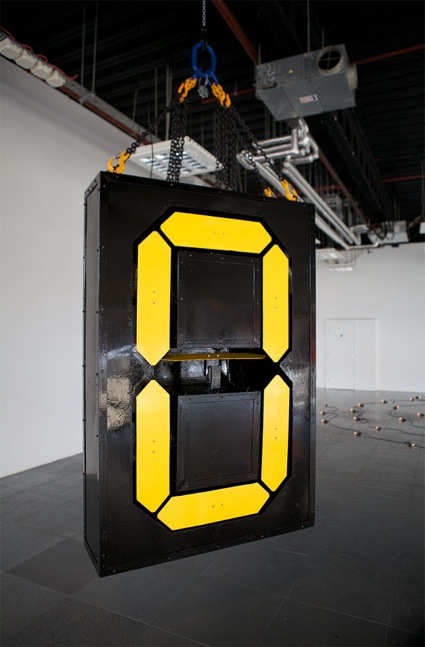 Ronin Cho, Weight of Unseen
Ronin Cho, Weight of Unseen
My favourite piece was without doubt Ronin Cho‘s Weight of Unseen which i had discovered at La Scatola gallery a few months ago. The kinetic sculpture is activated when a visitor pulls strongly on the chain from the hoist. The yellow number then changes but only a 0 or a 1 will appear, following the 00011010 combination, a binary code meaning end-of-file. In a simple and physical way, Weight of Unseen remind us of the place that the ‘immaterial’ digital world has taken into our life.
View of the installation at La Scatola in 2011
A corner of the fair was dedicated to Intuition and Ingenuity, an art exhibition that pays homage to Alan Turing.
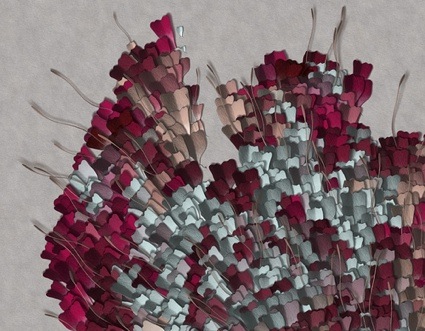 boredomresearch, Fragments of Lost Flights, 2012. Image boredomresearch
boredomresearch, Fragments of Lost Flights, 2012. Image boredomresearch
boredomresearch was showing his latest work. And it is as brilliant as you’d expect one of their projects to be. Fragments of Lost Flight which creates wing fragments generated by computational processes inspired by descriptions of Turing’s virtual machine known as a Turing Machine. Each wing fragment generated by the ‘machine’ exists only for the time it is on screen and is unlikely ever to be recreated. In nature the process that leads to familiar forms such as butterfly wings are exposed to intense selective pressure with only those of value for survival remaining, in contrast, ‘Fragments of Lost Flight’ treats all possibilities equally.
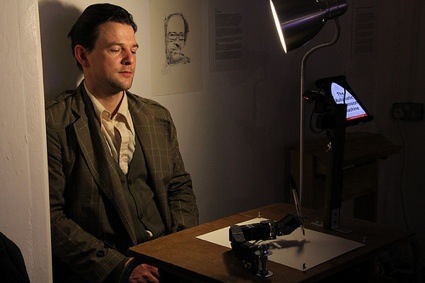
Paul, by Patrick Tresset, is another work i had seen in a London art gallery before. I’m glad Kinetica gave me the opportunity to catch up with all the stories that have remained in a rough draft stage.
Paul is an obsessive face-sketcher. After its camera has scanned your facial feature, its mechanical arm gets into action, drawing your portrait with a ballpoint pen. Its style is similar to Tresset’s own panoply. Paul is not the first drawing robot nor the first robots able to draw portraits.
What makes it different from the other drawing robots is that Paul investigates the drawing activity and more precisely face sketching. Paul uses some of the technology developed for the AIkon-II project at Goldsmiths, a research that uses computational modelling and robotics to answer questions such as What can explain that for a non-draughtsman it proves so difficult to draw what they perceive so clearly, while an artist is able to do so sometimes just with a few lines, in a few seconds? Furthermore, how can an artist draw with an immediately recognisable style/manner? How can a few lines thrown spontaneously on paper be aesthetically pleasing? Ultimately, AIkon-II aimed at developing a system that would draw in its own style. Like a human artist.
Here’s a video of Paul sketching a portrait the artist:
As what the exhibitors called ‘a kind of artistic Turing Test‘, some of the portraits were drawn/controlled remotely by the artist.
If you’re interested in seeing more of The Intuition and Ingenuity exhibition (and you should, it’s that good), keep an eye on its website because it will be touring the country over the coming months.
Elsewhere in the fair, the drawing robot party has only just started…
Balint Bolygo, Mappings, 2005
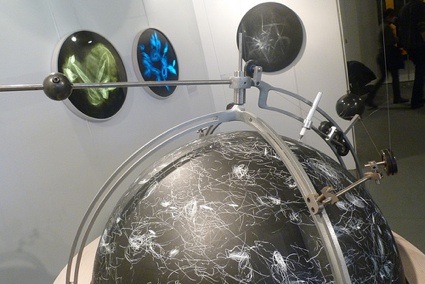 Balint Bolygo, Mappings, 2005
Balint Bolygo, Mappings, 2005
Balint Bolygo was showing Mappings, a rotating mechanized globe with no axis. Entirely black, its surface was slowly being covered with white scribbles. The pen was set in motion by two pendulums, which move whenever people interact with them. The mass of the earth is essentially creating the drawing, with the project playing on the idea of using a fundamental force in an imaginative way.
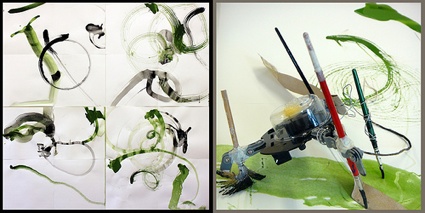 Shih Yun Yeo, Robo-Charge
Shih Yun Yeo, Robo-Charge
Shih Yun attaches bristle brushes to small robots and lets them draw motifs on the paper. The strokes are dictated by rules she made up and by using the element of chance from a dice.
Part 2 will be online tomorrow.
More images on the flickr pool.
Previously: Soundwaves at the Kinetica Museum.
